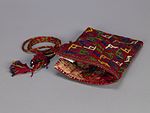Bag
About this object
History of use
Used to carry small items, such as grooming aids, tobacco, medicinal herbs, money, etc. and/or to transport dowry items.
Narrative
According to Clarke Abbott of Tradewinds Antiques, the person who collected this piece lived in Kabul in the early 1960s, doing ambassadorial work. He traveled widely throughout the area. He was killed in an automobile accident there, and no further information is available about him or his collection. The piece was subsequently acquired by Tradewinds Antiques in Vancouver at an unknown date, and the Museum of Anthropology purchased it in 1984, when the business was liquidating its stock.
Specific techniques
Square motifs worked in a dense interlocking (kesdi) stitch.
Physical description
Small, flat embroidered bag made by seaming two identical rectangular pieces together on three sides, leaving the fourth side and a side slit open at the top of the bag. The multi-coloured embroidered designs are composed of closely-spaced square motifs with a strip of alternating red, green and blue diagonal bands. A red and green braided cord is attached at the base of the side slit. Three tassels hang from the end of the cord, and each is trimmed with multicoloured glass beads. The embroidery is worked on a dark purplish-red silk textile and lined with machine printed floral textile.
Categories
Materials
